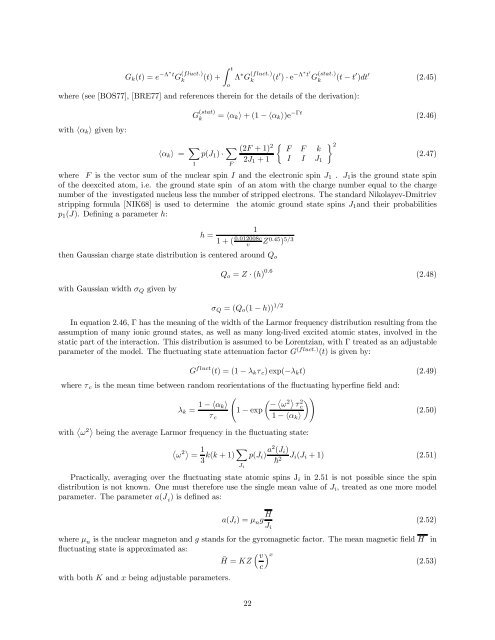coulomb excitation data analysis codes; gosia 2007 - Physics and ...
coulomb excitation data analysis codes; gosia 2007 - Physics and ...
coulomb excitation data analysis codes; gosia 2007 - Physics and ...
Create successful ePaper yourself
Turn your PDF publications into a flip-book with our unique Google optimized e-Paper software.
G k (t) =e −Λ∗t G (fluct.)k(t)+Z toΛ ∗ G (fluct.)k(t 0 ) · e −Λ∗ t 0 G (stat.)k(t − t 0 )dt 0 (2.45)where (see [BOS77], [BRE77] <strong>and</strong> references therein for the details of the derivation):with hα k i given by:G (stat)k= hα k i +(1− hα k i)e −Γt (2.46)hα k i = X 1p(J 1 ) · XF(2F +1) 22J 1 +1½ FIFIkJ 1¾ 2(2.47)where F isthevectorsumofthenuclearspinI <strong>and</strong> the electronic spin J 1 . J 1 is the ground state spinof the deexcited atom, i.e. the ground state spin of an atom with the charge number equal to the chargenumber of the investigated nucleus less the number of stripped electrons. The st<strong>and</strong>ard Nikolayev-Dmitrievstripping formula [NIK68] is used to determine the atomic ground state spins J 1 <strong>and</strong> their probabilitiesp 1 (J). Defining a parameter h:h =11+( 0.012008cvZ 0.45 ) 5/3then Gaussian charge state distribution is centered around Q owith Gaussian width σ Q given byQ o = Z · (h) 0.6 (2.48)σ Q =(Q o (1 − h)) 1/2In equation 2.46, Γ has the meaning of the width of the Larmor frequency distribution resulting from theassumption of many ionic ground states, as well as many long-lived excited atomic states, involved in thestatic part of the interaction. This distribution is assumed to be Lorentzian, with Γ treated as an adjustableparameter of the model. The fluctuating state attenuation factor G (fluct.) (t) is given by:G fluct (t) =(1− λ k τ c )exp(−λ k t) (2.49)where τ c is the mean time between r<strong>and</strong>om reorientations of the fluctuating hyperfine field <strong>and</strong>:Ãλ k = 1 − hα µ ki® − ω2τ 2 !c1 − exp(2.50)τ c1 − hα k iwith ω 2® being the average Larmor frequency in the fluctuating state:ω2 ® = 1 3 k(k +1)X J ip(J i ) a2 (J i )~ 2 J i (J i +1) (2.51)Practically, averaging over the fluctuating state atomic spins J i in 2.51 is not possible since the spindistribution is not known. One must therefore use the single mean value of J i , treated as one more modelparameter. The parameter a(J i) is defined as:a(J i )=μ n g H J i(2.52)where μ n is the nuclear magneton <strong>and</strong> g st<strong>and</strong>s for the gyromagnetic factor. The mean magnetic field H influctuating state is approximated as:³ v´x¯H = KZ(2.53)cwith both K <strong>and</strong> x being adjustable parameters.22
















